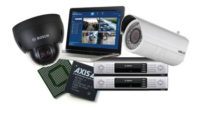In 1929, Hungarian author Frigyes Karinthy proposed the theory that the modern world was “shrinking” due to ever-increasing connectedness of human beings. He believed that any two individuals could be connected through at most five acquaintances, which is the original version of six degrees of separation. That was before the Internet, social media, and technological advancements that make the big world seem so much smaller today. Flash forward to 2014 and video has its own six degrees of separation — or rather, connection — within the industry. More and more conversations, projects, needs, and interactions with security are linking back to video.
“Video, not intrusion or access control, is more and more frequently the reason we’re being contacted for projects than ever before,” says this month’s cover dealer, Tim Lyvers, co-founder and chief executive officer (CEO) of Advanced Digital Solutions LLC (ADS), Charlotte, N.C., which has cornered a large share of the East Coast gaming market and provides mid- to large-scale integrated security solutions to various government and commercial clients.
“With the constant improvements made in IP cameras and better video analytics, combined with better graphical user interfaces (GUIs) from video management systems (VMS) and physical security information management (PSIM) solutions, along with more open architecture for integration to security sub-systems like access control, intrusion detection, etc., video surveillance is truly becoming the central nervous system of security,” Lyvers shares.
More affordable, technologically advanced, and integrated than ever before, video is driving more projects — and that’s generating high expectations for the 2014 video surveillance market. The widespread optimism for 2014 was reflected in SDM’s 2014 Subscriber Market Forecast Study, in which SDM’s subscribers’ opinions of the 2014 video surveillance market were remarkably high. Close to 9 in 10 dealers report high expectations for a good, very good, or excellent year in 2014 (See “Most Dealers Have Buoyant 2014 Sales Expectations” to on page 48). IMS Research predicts 12 percent growth globally for video surveillance. Additionally, the manufacturers, distributors, and integrators SDM spoke with for this feature article also expressed strong expectations for higher sales and growth in 2014.
“In 2013, we saw some of our largest video surveillance sales in the company’s history, with individual projects totaling more than 5,000 cameras,” says Wendi Burke, director of marketing, IQinVision, San Juan Capistrano, Calif., a provider of high-definition (HD) megapixel Internet Protocol (IP) cameras. The large-scale projects have predominantly consisted of new construction and system-wide migration from analog to IP. “2014 promises to be an even bigger year for our video surveillance sales,” she adds.
Video surveillance remains the fastest-growing market segment for Safeguard, reports Mike Bradley, president, Safeguard Security, Scottsdale, Ariz., a PSA Security dealer, because in 2013 Safeguard increased its emphasis on video surveillance in both the residential and small commercial markets, resulting in combined growth in video sales of about 30 percent. “We expect similar results in 2014 as we bundle multiple solutions and product offerings and continue to offer common platforms and mobile applications to access live video and review events,” Bradley says.
IP-based products, in particular, are predicted to have strong growth. See how this year’s numbers stack up against previous years in “IP Spending Expected to Climb UP in 2014” on page 50.
Another PSA Security dealer, Tom Hagen, president and CEO, Pro-Tec Design, Minneapolis, says the company’s revenue from sales and services related to IP video have been the fastest growing segment of the business for the last five years. “We expect that trend to continue in 2014 and beyond,” he adds.
“The outlook is excellent, the best it has been in years,” says Bill Bozeman, CPP, president and CEO of PSA Security Network®, Westminster, Colo., an electronic security cooperative established in 1974, encompassing more than 200 electronic security systems integrators, aligning them with over 200 vendor partners. “Our video sales were outstanding in 2013. From a percentage perspective, PSA had the best growth in a decade. 2012 was a decent year and we met our sales goals, but 2013 was an exceptionally strong year. I attribute this positive outlook to several variables including an improving economy; the general acceptance of video surveillance as a common-sense tool by the majority of Americans; improved technology leading to improved performance; and more bang for the buck as compared to the recent past,” Bozeman details.
He adds that in 2014 PSA expects to see less analog, more analytics, larger storage projects and more sophisticated VMS deployment.
Michael Flink, president, ADI Americas, Melville, N.Y., shares that the company experienced double-digit growth in 2013, buoyed by “tremendous IP growth rate both in units and revenue.” The company is expecting the same double-digit growth in 2014. ADI does predict flat analog revenue with a large increase in unit volume, which makes up for the average sales price decline.
The video surveillance market will grow in 2014 and analog to IP conversions will continue to be a driver,” predicts Jim Coleman, president of Operational Security Systems, Atlanta, and new president of Security-Net, a group of 20 independent systems integrators located throughout North America, plus three systems integrators internationally.
The need to replace aging analog system and gain the advantages of IP-based solutions is supported by low-cost encoders that are reducing the cost of analog-to-IP conversions. Price points for high-quality video encoders have dropped to as low as $80 per channel, according to Fredrik Nilsson, general manager, Axis Communications Inc., Chelmsford, Mass, a network video provider.
Encoders provide integrators the opportunity to develop a migration strategy for those customers who want to move to IP, but wish to retain their existing investment in analog CCTV.
“Encoders not only offer many of the benefits of moving to IP, but also help cultivate a long-term relationship with the customer when a migration plan is put in place,” Nilsson explains.
Another driver is technological advancements from traditional analog manufacturers into the IP space, which are allowing for more adoption from the traditional analog dealers. “They are adapting to easier-to- install IP technologies such as NVRs with built-in power over Ethernet (PoE) that are becoming readily available at more affordable prices than in the past,” says Marco Cardazzi, U.S. senior product manager, Video Surveillance, ADI Americas. “Not only is it making the technology easier to install, but it’s making it an easier process for traditional analog dealers to sell an IP solutions to their customers,” he explains.
Ron Oetjen, CPP, president, Intelligent Access Systems, Garner, N.C., shares that “a sizeable percentage of the company’s customers are tired of the unusable video quality from their legacy analog systems.” He expects to see continued upgrades to those systems in 2014. Intelligent Access Systems, which recently was acquired by Carrollton, Texas-based Securadyne Systems, experienced growth in the 20 percent range in video surveillance overall in 2013, but had 45 percent growth in the IP video surveillance equipment subset.
“Customers see megapixel quality video and cameras in their mobile devices and all over the consumer electronics industry and are expecting the same from their video surveillance system,” Oetjen says, which is why image quality will strongly impact the market in 2014 — especially IP.
When there was no high resolution, people took image quality for granted, but today if you put images from high-resolution cameras in front of them, they see the detail and know that is what they want, says Kosta Mellos, video product manager, Interlogix/Lenel, Bradenton, Fla. “It is a basic advancement driven by needs and expectations. Technology details like that will change the picture of video surveillance,” Mellos adds.
New imaging advancements include the first introduction of a 4K Ultra HD imaging device for security surveillance, shares Daniel Gundlach, vice president of marketing – North America, Bosch Security Systems Inc., Fairport, N.Y.
“4K imaging delivers 8MP resolution that conforms to the SMPTE HD standard. The larger and richer video provides a tremendous advantage in detail capture with crisp, vivid images even when zoomed in digitally. This will make 4K imaging ideal for tracking people, capturing facial characteristics and numbers, and for large-area surveillance,” Gundlach describes. Of course, greater resolution creates stronger demands for storage and playback. Dynamic Transcoding technology provides high-resolution image playback within limited network connections. “This is one solution of many that will help the market cope with growing resolution demands in the upcoming year,” Gundlach predicts.
On the edge, there is always the premium to continue to lower bandwidth consumption and storage. “If you increase the resolution by two times or four times you will increase the data exchange rate of the camera, too, and that can weigh down the network or increase the cost to storage. As we continue to improve the resolution of IP cameras there is always the premium of being very thrifty of the network usage or the data output,” says Steve Carney, director, product management, Video, Tyco Security Products, Westford, Mass.
The demand for larger numbers of high megapixel cameras and their impact on data ingestion/bandwidth are forcing storage manufacturers to a greater adherence to quality and more importantly, longevity, says Jeff Burgess, president, BCDVideo, Northbrook, Ill.
He also sees many larger customers more involved in the security solution because the system they recently purchased proves unable to handle the video stream throughput when the customer upgraded to high-resolution cameras.
“For many customers, today’s purchase is a second-generation video system. Having been burnt once before, they are expecting better quality and scalability. Today more than ever, more emphasis is placed upon data center-quality standards for video servers as they had been on traditional IT servers, and we are seeing greater influence by corporate legal departments dictating the minimum standards within an IP video server,” Burgess shares.
End users are absolutely getting more engaged with technology and its impact on their businesses, agrees Matt Tengwall, vice president of North American sales at Verint, Melville, N.Y. “We find our conversations reaching into new departments, such as marketing, IT, operations, workforce management and the C-suite. The customer base understands that video is an existing investment that could add more value by being used in additional ways, adding to the overall return on investment (ROI).”
ROI grows when users of surveillance video begin to understand that video is more than just an image, says Larry Bowe, president, PureTech Systems, Phoenix.
“Up until now, users thought of video as a series of still images. Now they are beginning to realize that video data contains a vast amount of information that can be interrogated and evaluated. This understanding by the end user will drive increased sales in forensic video tools and fuel customer demand for new ways they would like to use and evaluate their video data,” Bowe believes.
A ROI and total cost of ownership model are critical to justifying additional capital investment such as replacement and enhancements to existing surveillance systems, encourages Dave Tynan, vice president of marketing and business development, MicroPower Technologies, San Diego. “When these two criteria are met, surveillance and security departments compete in an enterprise environment with other department capital investments,” he observes.
When customers understand the benefits video surveillance can offer, sales will follow in 2014. The industry just has to get their attention first, Lyvers advises.
“HD cameras and video analytics seem to garner the most interest right out of the gate with customers. Part of this is because they are easy concepts to demonstrate and wrap your head around and of course the dramatization of technology that many TV shows and movies provide also helps. Where we try to differentiate ourselves once we have the customer’s attention is through high level integrations centered on the customer’s business operations,” he explains.
“Just recording video and waiting for something bad to happen is like buying an expensive smartphone and not using any apps — you’re not maximizing your value. You are certainly not getting your ROI. In 2014, we are going to continue to look for and focus on integrations with video as the center.”
Outlook for Video System Sales in the Education Market
Security equipment installations and upgrades as well as policies will vary by school district and university, as pointed out in “Trends for 2014—Video Surveillance Trends for the Year Ahead,” a report produced by IHS Technology, Englewood, Colo. The report finds that video surveillance will be the focal point in the years to come, expecting growth of video surveillance in schools to be twice as fast as that of access control through 2017.
“With all of the recent school shooting incidents, we are seeing a rise in both interior and exterior video surveillance at educational facilities. Many of the systems are using analytics for perimeter protection, along with motion detection, to monitor areas that are often unoccupied during school hours.
Many schools are also looking into facial recognition programs to identify parents, vendors and potential offenders,” relates Bob Stockwell, chief technology officer, STANLEY Security, Naperville, Ill.
In 2001 Hikvision USA, City of Industry, Calif., had global revenue of $625 million. In 2013 the company expects 60 percent growth and $1.6 billion in sales. In the U.S. market alone, Hikviison is expecting 100 percent growth. “The strong growth is attributed to the efforts of the last few years in sales and marketing and our growing reputation for quality, durable cameras,” says Oliver Zhang, vice president of Hikvision USA.
SDM Asked: “Which Vertical Market Do You Think Will Offer the Most Potential for Growth in 2014?”
“The market segments where we see healthy customers for video surveillance is in Safe City deployments, transportation (rail and airports, for example), banking, utilities and energy. In these markets, the expectation of video security is changing. Today’s organizations want to use their technologies to achieve more than video recording and video streaming for security. Video surveillance solutions are expected to help improve security and overall operations. To achieve this, video surveillance systems have to fuse multiple systems and different sensors together.” — Eran Wachman, vice president of product management, Verint
“There is a change in the way people are looking at large venues — parking lots, warehouses, stadiums, meeting halls, athletic facilities and other large stadiums. Today with megapixel, we can do things now that we couldn’t effectively do before and we can meet the desire to put cameras so you can recognize a face in every seat or every license plate in a lot. Using standard-definition IP cameras it could take 2,000 cameras to do that in stadium, which means cables everywhere. Plus, who is going to watch that many cameras? With today’s technologies we can do a whole stadium with 75 cameras with a clear image on every seat. Costs are dropping, quality is improving, the monitoring of those large systems is changing, and the economic justification is higher, so we anticipate strong growth.” — Scott Schafer, Arecont Vision.
“The banking space is particularly interesting. They have been slow to adapt to IP, but for good reason. The solution to their problem is not necessarily solved with the benefits of network-based products. Coupled with the fact that they have enormous investment in analog infrastructure, most banks do not see the need to make the transition. However, technologies such as high-definition analog have generated great interest in the banking community.” — Frank De Fina, senior vice president of sales and marketing, Samsung Techwin America, Ridgefield Park, N.J.
“There is effort and growth in municipalities and a lot of emphasis on public/private partnerships. We completed a system in New York that is an example of a private entity working with the government to create a very sophisticated environment to safeguard the 8 million annual passengers that travel the New York Harbor on NY Waterway ferries. Funding still will come through grants in 2014 but more municipal projects will integrate private funding as well.”— Kosta Mellos, Interlogix/Lenel
“City safety is big and will grow in 2014. In most cases, it is big projects involving large numbers of cameras [which Hikvison has the volume to handle. Globally, it daily produces 22,000 cameras and 7,000 pieces of back-end equipment]. In North America retail, gaming, and hospitality are all strong markets. Retail is behind from the downturn on the economy, when upgrades and new systems were put on hold. With the recovery the solutions are now more affordable and integrated systems and installation cost reductions make retail a strong vertical market in 2014. — Oliver Zhang, Hikvision USA, City of Industry, Calif.
PPVAR Targets Video Verification Standards, Education in 2014
Video verification increased in 2013, aided by technological advancements, changing central station capabilities and falling IP camera prices, which were key barriers to mass installation and usage. That trend will continue in 2014. “The video market continues to mature at an accelerated rate. Customers are increasingly choosing video as a cost-effective means for alarm verification and false alarm reduction,” says Steve Walker, vice president, Customer Service, STANLEY Security. The trend to cost-effective video verification has strong support from law enforcement and the insurance industry, and its growth is being championed by Partnership for Priority Video Alarm Response (PPVAR). Read “Defining Video Verification’s Future” for video verification’s development and the affect it will have on your business: http://bit.ly/1iCrkwD.
The most important goals for the PPVAR in 2014 are:
1. The completion of the new video verification standard that addresses the installation of video alarm systems, the monitoring best practices regarding the central station towards the property/owner, and the monitoring best practices regarding the central station towards the PSAP.
2. The education committee creating content and curriculum on the benefits/applications of video-verified alarms for insurance actuaries, insurance agents, and insurance policy holders.
4. Beginning to work with insurance organizations such as Verisk to attempt to quantify the loss control benefits of video-verified alarms to justify greater insurance discounts (and insurance mandates) for their policy holders.
3. The promotion of the benefits of video-verified alarms to all the stakeholders in the battle against property crime:
• outreach to police chiefs (especially at the state level)
• outreach to insurers (especially loss control people)
• sSecurity events, including a PPVAR Roundtable at ISC West, Thursday, April 3, 4:00 p.m. to 6:00 p.m., which will include two different panels, law enforcement/insurance and the alarm industry (including John Mack of Imperial Capital).
Video: Come Rain, Come Shine, Come…Anything?
“There are now outdoor-ready PTZ domes with integrated cooling for extremely hot, desert-like environments and ones for extremely cold, arctic-like temperatures. There are IP cameras that handle blinding sunlight and shadows remarkably well, and ones that can see color video in the lowest of light. We’re also seeing cameras with vibration stabilization, shock detection and defogging technologies. When joined with the likes of thermal network cameras, wireless transmission, edge storage and intelligent software, integrators who remain up-to-date with the latest innovations can design a video solution for literally any environment in the United States, Canada and Mexico,” says Fredrik Nilsson, Axis Communications.
Approaching Video Differently in 2014
Video Analytics
Expect to see these technologies gain traction in 2014
In its latest report on video content analysis (VCA), HIS Technology forecasts that the number of video surveillance devices with free analytics will grow rapidly in 2014 and beyond. However, so, too, will the market for “chargeable” analytics applications. In fact, the market for video surveillance devices with chargeable analytics is forecast to be worth over $500 million in 2017.
Why will analytics grow? “Because with the proliferation of video comes the need to automate surveillance of the video using video analytics as it’s just not scalable (or humane) to ask humans to perform that task,” says Larry Bowe, PureTech Systems.
“Typically, in the past, analytics have been server-based, but we are seeing a trend toward more edge-based analytics. This trend reduces the cost associated with analytics by removing the head-end hardware and allowing it to be licensed at the camera. This way, customers can purchase only the analytics needed for that camera, instead of a server-based license,” describes Steve Walker, STANLEY Security.
Illy Gruber, product marketing manager for NICE Systems’ security business, Ra'anana, Israel, foresees video analytics applications extending beyond security in order to optimize operations, even provide marketing insight. Businesses will also be leveraging video to gather customer behavior data,” she describes.
Panoramic Cameras
Panoramic / 360 degree technology has really accelerated the last five years, shares Scott Schafer, executive vice president, Arecont Vision, Glendale, Calif.
In fact, the No. 5 trend listed by IHS Technology in “Trends for 2014—Video Surveillance Trends for the Year Ahead” is panoramic cameras. “The big video surveillance camera category winner in 2014 will be 180-/360-degree panoramic network cameras, with global unit shipments forecast to increase by more than 60 percent year-on-year,” according to IHS Technology in the report.
Arecont Vision is ready to capitalize on the growth with new offerings that combine megapixel cameras with wide dynamic range (WDR). By combining long and short exposures in the same field-of-view, WDR maximizes the amount of detail in both bright and dark areas of a scene. The WDR performance of Arecont Vision cameras represents an up to 50dB improvement (300X) in dynamic range compared to conventional cameras.
“No end user wants panoramic video that is pixelated and not very good images on the edges. The industry needs to provide good resolution at all parts of the scene. Today’s panoramic technology creates situational awareness and proves great images, and reduces the cost of projects since fewer cameras are required to cover the same area,” Schafer says.
Social Video
“In the coming year, we’ll see an increase in the need to mine video across different protocols and across different networks to drive real-time knowledge and awareness. This includes pulling video in real time from very different networks. For example, law enforcement can pull video from multiple sites —streets, stadiums, hotels, subway platforms, etc. — into one command center to be able to see everything in real-time and react quickly in the event of an incident,” says Yoav Stern, president and CEO, DVTEL, Ridgefield Park, N.J.
IHS Technology reports that “the prevalence of smartphones, with cameras and Internet connectivity, combined with social media apps, such as Vine or Instagram, has led to the first ‘crowd-sourced’ data collection for a police investigation in 2013” and the company lists “Big Data: Crowd Sourcing Video Surveillance and Social Media Analytics” as the No. 2 trend in 2014 IHS believes that social media will hwlp create solutions that improve police incident responses in 2014 and beyond.
Mobile Video
Cisco estimates 1.4 zettabytes of global end-user IP traffic in 2017. And here’s the kicker: That’s more IP traffic than the internet has seen in the last 18 years together. Mobile video will grow 16-fold from 2012 to 2017, and account for 66 percent of all mobile data traffic during that year.
“Mobility has gone from a nice to have to a must have and it has fostered the ‘anywhere, anytime’ mentality for access control and video. That has a premium impact on bandwidth usage, because it is not only moving from a camera to a recorder, but to a mobile device, as well,” says Steve Carney, Tyco Security Products.
BHSC Research Examines Residential Video Demand
BestHomeSecurityCompanys.com (BHSC) frequently conducts wide-reaching market polls and reviews home security companies. Read more about the company and its review process at http://bit.ly/KLh8Gh.
This year SDM asked the company to conduct a national survey among end users regarding the importance of offering video in home security systems. See the full results in this video at sdmmag.com/home-security-video.
One question BHSC asked was, “How important is it for home security companies to provide video surveillance equipment in their standard security packages?” (1 = not important and 10 = very important). More than 17 percent of respondents said it was very important (10) for home security companies to include video surveillance in standard security packages.
“On our scale respondents averaged a 6, meaning they were inclined to want video surveillance in standard home security packages,” shares Bryan Lovgren, director of public relations for BHSC.
“Consumers want dynamic and more technologically standard home security packages,” he adds. “We are noticing a higher volume of customers asking for video surveillance to be included in home security packages. Companies can really take advantage of a growing market by weaving video surveillance into their standard packages, building up their online presence, and focusing on reliable equipment.”
Video Standards in 2014
2014 is predicted to include greater adoption of open standards across the board, which is much needed, says John Smith, Honeywell Security. “Open standards are helping the industry progress as a whole, but the practice isn’t as ‘open’ as it potentially could be — it is still in the maturation stage.”
Integrated solutions and the end user demand for that integration is becoming more common.
“PSIA and ONVIF standards continue to evolve for access systems that will be able to tie together end users’ video with access as well as integrate with the user’s other systems, such as intrusion.
This is a step forward, because currently ONVIF standards are well covered for device integration, not so much for the overall solution. It’s great that we’re seeing progress here, as it will provide the end user with more flexibility and cost savings,” says Chris Koetsier, Honeywell Security.
ONVIF, the global standardization initiative for IP-based physical security products, will be focused on upcoming releases in 2014, including the progress of Profile G for recording and storage, Profile C for physical access control systems and other technical developments.
David Bunzel, executive director, the Physical Security Interoperability Alliance (PSIA), a global consortium of physical security providers headquartered in Santa Clara, Calif., says PSIA is focused on promoting the interoperability of IP-enabled devices, which includes enhancing the PSIA’s Recording and Content Management (RaCM) specification, which covers video storage and retrieval.
“We’ll essentially be streamlining the spec so a wide range of vendors can incorporate it into their products. That work fits in with our vision of video data being made more accessible to a range of security and enterprise systems,” Bunzel says.
UL recently entered the video space with the publication of a new standard, UL 2802—Performance Testing of Camera Image Quality. The standard looks at nine key performance attributes of video image quality. Each of the nine performance attributes will have a published score to facilitate the objective comparison between two or more cameras. Find more details in the white paper at http://bit.ly/KLfGn9.
Video ‘Finds a Home’ in Residential Security Offerings
A growing component of “smart” residential systems is video — and that trend will continue in 2014.
“Perimeter or external video continues to be a trend for residential end users. They find value in being able to keep an eye on external properties to protect valuables stored in a garage, for instance. They also can use a perimeter camera to verify intrusion alerts, which helps in terms of ‘peace of mind’ and can verify a false alarm before the authorities are called,” says Chris Koetsier, director of product marketing, Honeywell Security, Melville, N.Y.
Just as mobility and remote access are growing in demand in the commercial space, there is also a spike in this demand from residential end users as well, confirms John Smith, senior product marketing manager, Honeywell Security.
“There’s also an extended demand for hosted services by homeowners. Homeowners like having the ability to look in to their home when they are not physically there. They might use this capability to do things such as: determine whether a package has been delivered, check in on kids arriving home from school, or see who just rang the doorbell.”
2013 saw incredible growth in video observation services with traditional residential security systems, says Larry Folsom, president of I-View Now of Henderson, Nev. “I believe big differences in 2014 will be the mainstream acceptance of video verification, additional services added to the current observation video platforms, and the central station-centric shift in Video Surveillance as a Service offerings (VSaaS).”
Folsom adds that the residential market has been greatly impacted by consumer-grade observation services such as Total Connect and Alarm.com. “These systems supply actionable video (Johnny is home), event-based storage, and allow the home owner an unprecedented understanding of the status of their homes.”















